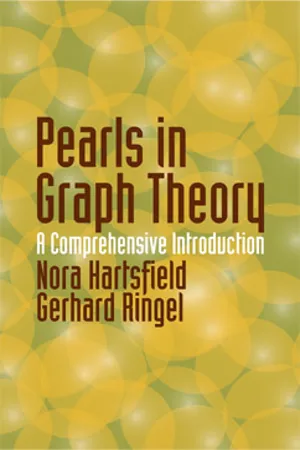
eBook - ePub
Pearls in Graph Theory
A Comprehensive Introduction
Nora Hartsfield, Gerhard Ringel
This is a test
- 272 pagine
- English
- ePUB (disponibile sull'app)
- Disponibile su iOS e Android
eBook - ePub
Pearls in Graph Theory
A Comprehensive Introduction
Nora Hartsfield, Gerhard Ringel
Dettagli del libro
Anteprima del libro
Indice dei contenuti
Citazioni
Informazioni sul libro
`Innovative introductory text . . . clear exposition of unusual and more advanced topics . . . Develops material to substantial level.` — American Mathematical Monthly
`Refreshingly different . . . an ideal training ground for the mathematical process of investigation, generalization, and conjecture leading to the discovery of proofs and counterexamples.` — American Mathematical Monthly
` . . . An excellent textbook for an undergraduate course.` — Australian Computer Journal
A stimulating view of mathematics that appeals to students as well as teachers, this undergraduate-level text is written in an informal style that does not sacrifice depth or challenge. Based on 20 years of teaching by the leading researcher in graph theory, it offers a solid foundation on the subject. This revised and augmented edition features new exercises, simplifications, and other improvements suggested by classroom users and reviewers. Topics include basic graph theory, colorings of graphs, circuits and cycles, labeling graphs, drawings of graphs, measurements of closeness to planarity, graphs on surfaces, and applications and algorithms. 1994 edition.
`Refreshingly different . . . an ideal training ground for the mathematical process of investigation, generalization, and conjecture leading to the discovery of proofs and counterexamples.` — American Mathematical Monthly
` . . . An excellent textbook for an undergraduate course.` — Australian Computer Journal
A stimulating view of mathematics that appeals to students as well as teachers, this undergraduate-level text is written in an informal style that does not sacrifice depth or challenge. Based on 20 years of teaching by the leading researcher in graph theory, it offers a solid foundation on the subject. This revised and augmented edition features new exercises, simplifications, and other improvements suggested by classroom users and reviewers. Topics include basic graph theory, colorings of graphs, circuits and cycles, labeling graphs, drawings of graphs, measurements of closeness to planarity, graphs on surfaces, and applications and algorithms. 1994 edition.
Domande frequenti
Come faccio ad annullare l'abbonamento?
È semplicissimo: basta accedere alla sezione Account nelle Impostazioni e cliccare su "Annulla abbonamento". Dopo la cancellazione, l'abbonamento rimarrà attivo per il periodo rimanente già pagato. Per maggiori informazioni, clicca qui
È possibile scaricare libri? Se sì, come?
Al momento è possibile scaricare tramite l'app tutti i nostri libri ePub mobile-friendly. Anche la maggior parte dei nostri PDF è scaricabile e stiamo lavorando per rendere disponibile quanto prima il download di tutti gli altri file. Per maggiori informazioni, clicca qui
Che differenza c'è tra i piani?
Entrambi i piani ti danno accesso illimitato alla libreria e a tutte le funzionalità di Perlego. Le uniche differenze sono il prezzo e il periodo di abbonamento: con il piano annuale risparmierai circa il 30% rispetto a 12 rate con quello mensile.
Cos'è Perlego?
Perlego è un servizio di abbonamento a testi accademici, che ti permette di accedere a un'intera libreria online a un prezzo inferiore rispetto a quello che pagheresti per acquistare un singolo libro al mese. Con oltre 1 milione di testi suddivisi in più di 1.000 categorie, troverai sicuramente ciò che fa per te! Per maggiori informazioni, clicca qui.
Perlego supporta la sintesi vocale?
Cerca l'icona Sintesi vocale nel prossimo libro che leggerai per verificare se è possibile riprodurre l'audio. Questo strumento permette di leggere il testo a voce alta, evidenziandolo man mano che la lettura procede. Puoi aumentare o diminuire la velocità della sintesi vocale, oppure sospendere la riproduzione. Per maggiori informazioni, clicca qui.
Pearls in Graph Theory è disponibile online in formato PDF/ePub?
Sì, puoi accedere a Pearls in Graph Theory di Nora Hartsfield, Gerhard Ringel in formato PDF e/o ePub, così come ad altri libri molto apprezzati nelle sezioni relative a Mathematics e Mathematics General. Scopri oltre 1 milione di libri disponibili nel nostro catalogo.
Informazioni
Argomento
MathematicsCategoria
Mathematics GeneralChapter 1

BASIC GRAPH THEORY
1.1 Graphs and Degrees of Vertices
Before we give any definitions and theory, let us consider the following example. There is a basket containing an apple, a banana, a cherry and a date. Four children named Erica, Frank, Greg and Hank are each to be given a piece of the fruit. Erica likes cherries and dates; Frank likes apples and cherries; Greg likes bananas and cherries; and Hank likes apples, bananas, and dates. Figure 1.1.1 describes the situation. The problem is to give each child a piece of fruit that he or she likes. The reader is invited to find a solution. One can see the advantage of using Figure 1.1.1 as an aid to solving the problem.
Figure 1.1.1 is, in fact, an example of a graph. Another example with which we are all familiar is a road map. The map in Figure 1.1.2 is greatly simplified, of course. It shows some different ways of driving from San Jose to San Francisco.

Figure 1.1.1

Figure 1.1.2
Chemists use diagrams to picture molecules, and these diagrams are also graphs. Usually the hydrogen atoms are omitted from the diagrams by the chemists using shorthand structure, but the Kekulé structure includes them.

Figure 1.1.3. Water, H2O.

Figure 1.1.4. Butane and isobutane, C4H10.
In Figures 1.1.6 and 1.1.7 the labels for carbon, hydrogen, and oxygen have been left out. See Figure 1.3.6 for another molecule C60.
Graph theory is used in designing printed circuits for use in electronics devices. Circuits printed on silicon chips must be designed differently from those using insulated wires, since the conducting portions cannot cross one another. The graph of Figure 1.1.8 shows part of a printed circuit used in a computer.

Figure 1.1.5. Cyclohexane, C6H12.

Figure 1.1.6. Aspirin, C9H8O4.
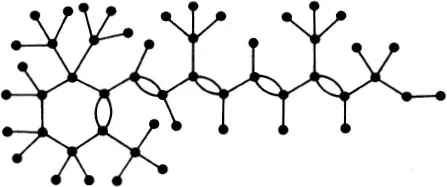
Figure 1.1.7. Vitamin A, C20H30O.
Algorithms can also be described by graphs. The graph of Figure 1.1.9 is a chart of the steps used in an algorithm for solving a certain problem using a computer.

Figure 1.1.8. Portion of a printed circuit

Figure 1.1.9
In the study of lattices and Boolean algebras, graphs arise as diagrams of these structures. Those who have studied set theory will recognize the diagrams of Figures 1.1.10 and 1.1.11 as lattices of subsets. For convenience, we use shorter notation for sets; for example, we write ABD for the set {A, B, D}. The diagrams of Figures 1.1.10 and 1.1.11 show all subsets of the set at the top. If one set is derived from another by deleting one element, then the two sets are connected by a line in the diagram.
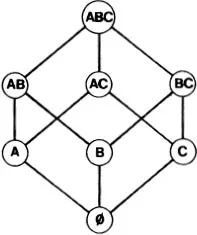
Figure 1.1.10. The lattice of subsets of ABC.
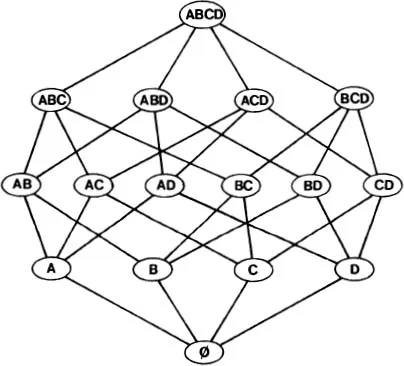
Figure 1.1.11
The different factorizations of the integer 60 are shown in the diagram of Figure 1.1.12. Some more examples of graphs are shown in Figures 1.1.13, 1.1.14, 1.1.15, 1.1.16, and 1.1.17.
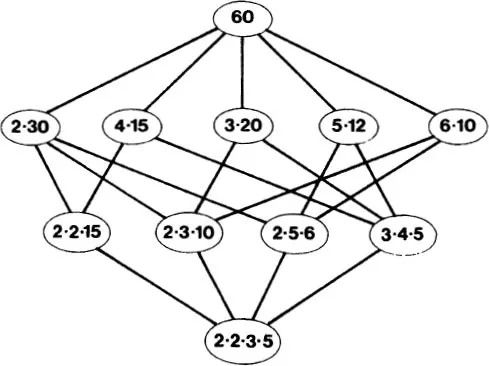
Figure 1.1....
Indice dei contenuti
Stili delle citazioni per Pearls in Graph Theory
APA 6 Citation
Ringel, G. (2013). Pearls in Graph Theory ([edition unavailable]). Dover Publications. Retrieved from https://www.perlego.com/book/112656/pearls-in-graph-theory-a-comprehensive-introduction-pdf (Original work published 2013)
Chicago Citation
Ringel, Gerhard. (2013) 2013. Pearls in Graph Theory. [Edition unavailable]. Dover Publications. https://www.perlego.com/book/112656/pearls-in-graph-theory-a-comprehensive-introduction-pdf.
Harvard Citation
Ringel, G. (2013) Pearls in Graph Theory. [edition unavailable]. Dover Publications. Available at: https://www.perlego.com/book/112656/pearls-in-graph-theory-a-comprehensive-introduction-pdf (Accessed: 14 October 2022).
MLA 7 Citation
Ringel, Gerhard. Pearls in Graph Theory. [edition unavailable]. Dover Publications, 2013. Web. 14 Oct. 2022.